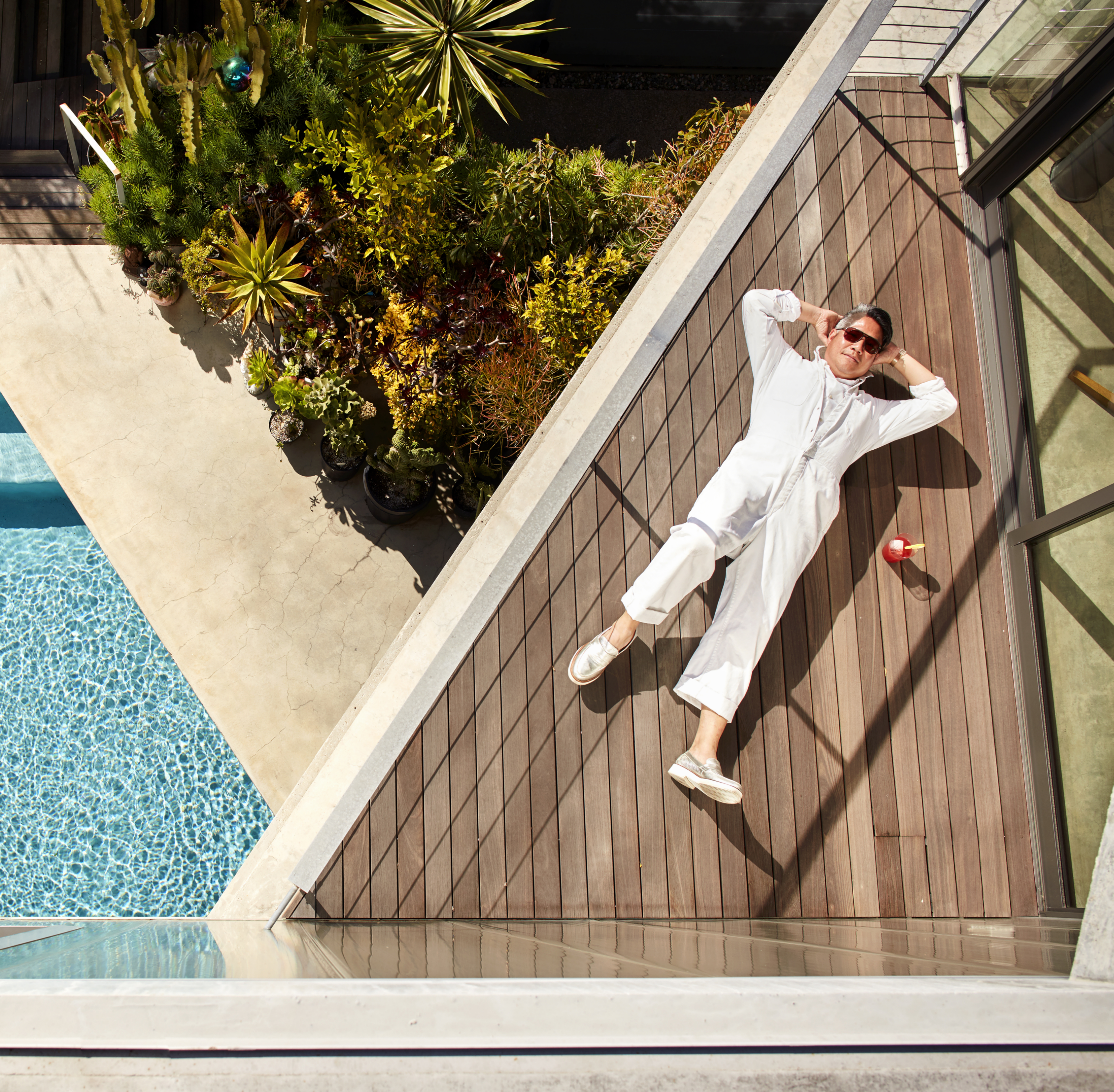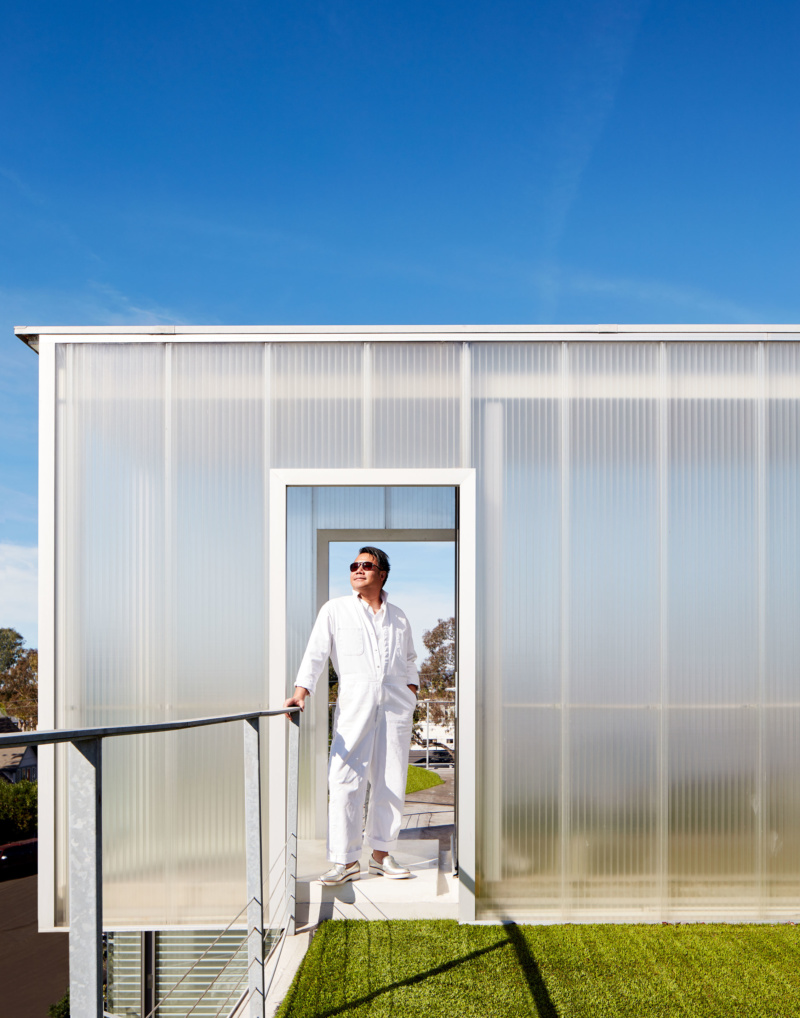
On the grey January day we meet at his Culver City studio—as on nearly every other day of the year—Kulapat Yantrasast is wearing a boiler suit. The elegant navy one-piece, the Thai-born architect reveals, is a copy of a Comme des Garçons original, bought in Japan in the mid-90s, that he had specially tailored on a trip to Bangkok. Comme only makes it in two colors; Yantrasast now owns around 30, in assorted fabrics, for every occasion. He wears his black edition, paired with a crisp shirt and bow tie, to fancy galas.
Yantrasast’s ubiquitous boiler suit neatly encapsulates his architectural style: functional, comfortable, pragmatic, but also elegant and original— unafraid to stand out in a crowd.
His practice wHY, which has offices both in New York and Los Angeles, has designed private residences, public landscaping projects, exhibitions, products and furniture. But it is for his work in the art world—designing museums, galleries, private foundations and a studio for artist couple Jonas Wood and Shio Kusaka—that he is best known. He tells me he currently has around 30 projects on the go, including an extension to the Asian Art Museum, San Francisco, a renovation of galleries in the Metropolitan Museum of Art, NY, a design for the Cheech Marin Center for Chicano Art, Culture and Industry in Riverside, California, and a private museum in Manila, the Philippines. He also created the striking temporary structure for the first Frieze LA art fair in February at Paramount Studios. Ironically, Yantrasast never paid much attention to art as a kid.
“Growing up in Bangkok it’s all about the honor of the family, making your family proud,” says Yantrasast. His father was an engineer, his mother a school teacher. He was an A-student and his parents hoped he would be a doctor, so his mother especially was disappointed when he announced his ambition to train as an architect. “Architecture was a middle ground for me between creativity and practicality,” he says.
Although he was aware of a few practicing architects in Bangkok, he says he really had little idea of what the profession entailed. What motivated him, he says, was a desire to find identity—“Not only my identity but the identity of the country I lived in,” he explains. He resented the glass skyscrapers popping up in Bangkok, signifiers of global prosperity that reflected nothing of indigenous Thai culture. He was mystified by the black leather sofas in his parents’ home—middle-class status symbols—that were totally unsuited for life in Thailand. “I remember how uncomfortable those were, because they’re very hot in the sun, and they were very sticky because it’s so humid there,” he says. “We all liked to just sit on the floor; we’d never sit on the couches.”

Drawn by famous Japanese starchitects of the day—including Tadao Ando, Toyo Ito, Arata Isozaki—in 1990, Yantrasast left Thailand and enrolled in graduate school at the University of Tokyo. He was impressed by the way the work of these architects “all smelled Japanese,” distilling an essence of their native culture. After receiving his PhD, he took a job as an associate in Ando’s office. After eight years, however, he began to feel that his skills were not being fully utilized. “I was missing what I had a talent for, which is colors, variety, the smell of stuff. That kind of human wetness.” He draws a culinary analogy: “Ando’s work is like Japanese food. It’s all about precision and clarity of thought, and the ingredients support that. I was coming from the Thai food culture that is about mixing, blending, improvisation, creating something out of nothing.”
From Japan, Yantrasast moved to LA. At the age of 34, he wanted neither to return to Thailand (“to live in my parents’ house”) nor to move to NY, where he feared he would be consigned to loft renovations and boutique interiors. LA offered a sense of freedom, a stronger connection to Asian culture, and the possibility of doing real architecture. In 2003 he founded a practice with an old classmate from Tokyo, Yo-ichiro Hakomori, which they called wHY Architecture, workshop Hakomori Yantrasast. In 2012 Hakomori left the practice to return to teaching, and the practice rebranded simply as wHY.
wHY’s first major project came about purely by chance. Under Ando, Yantrasast had worked on the new building for the Modern Art Museum of Fort Worth, Texas. The director of Michigan’s Grand Rapids Art Museum—at the time in early stages of planning a new building—visited Fort Worth, and fell in love with Ando’s design. She was told that, as luck would have it, the young Thai architect who had helmed the project had just set up a practice in LA. She gave Yantrasast a call.
“I was still a kid! I was not even 40 yet!” he says. When the minimalist concrete building was completed, Yantrasast asked the artist Ellsworth Kelly, whose work features prominently in the museum’s lobby, if he thought the design was “Ando-lite.” “No, no, no!” Kelly reassured him. “Ando is Japanese, so his spaces are all about control. You’re a Thai person; you’re very generous. You like people to look here, look there, to have options.” The observation struck a chord with Yantrasast.
The Grand Rapids Art Museum remains an important project in his portfolio, but it is classical compared to some of his more recent, more playful and complex work. Yantrasast says it reflected its city—“very Dutch, very Calvinist.” He contrasts it with his design for the Speed Art Museum in Louisville, Kentucky, which was completed in 2016. In his 2009 project proposal, he coined the term “acupuncture architecture,” an approach that has become a wHY trademark. When confronted with the original museum, which had been altered and extended over time, his response was that it was “completely congested.” There was no sense of clarity, of circulation. He felt as if he wanted to put an acupuncture needle to it and “unclog these problems in this body.”
“I like to look at buildings as personalities, as bodies with lives,” he says. “When I first see a building, I ask myself, if that building was a person, would I like to know more about them? In a building I look for generosity, I look for a sense of complexity that unfolds over time. I sometimes look for opposite interests within a building. Those are the qualities that I look for in my friends also.”




